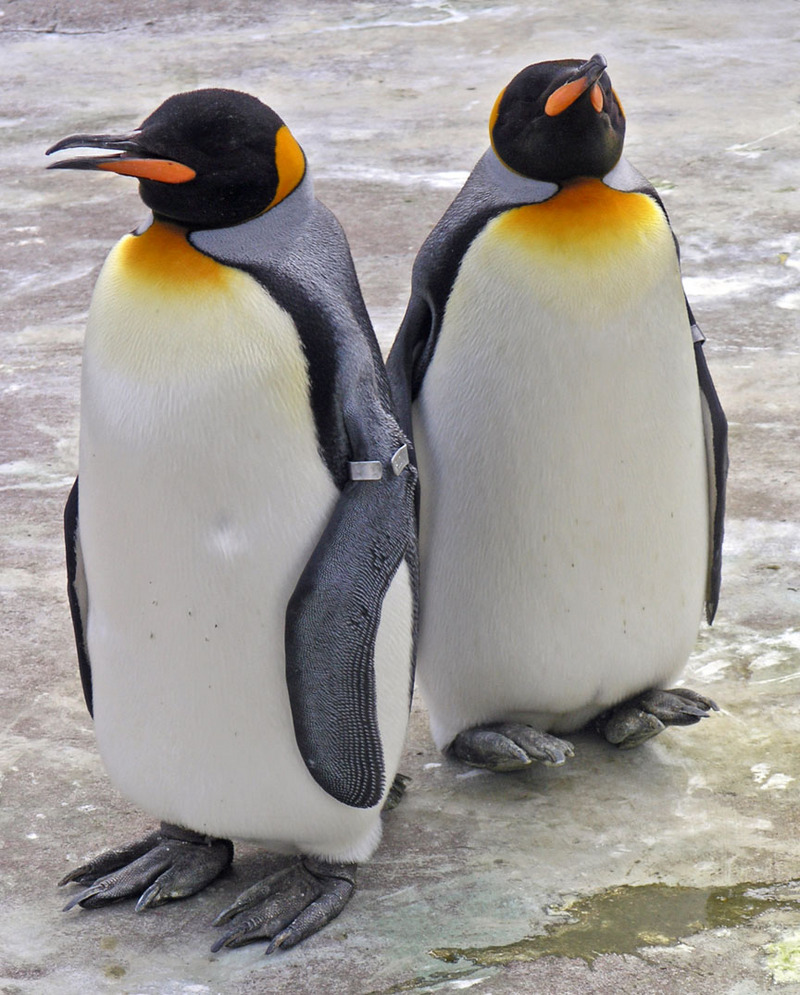King Penguin (Aptenodytes patagonicus) - Wiki King Penguin
From Wikipedia, the free encyclopedia
[Photo] King Penguins, Edinburgh Zoo. Photo by http://en.wikipedia.org/wiki/User:SeanMack
The King Penguin (Aptenodytes patagonicus) is the second largest species of penguin at about 90 cm (3 ft) tall and weighing 11 to 15 kg (24 to 33 lb), second only to the Emperor Penguin. There is a world population of approximately four million King Penguins, divided into two subspecies (A. p. patagonicus and A. p. halli). These populations are thought to be on the increase.
King penguins eat small fish, mainly lanternfish, and squid and rely less than most Southern Ocean predators on krill and other crustaceans. On foraging trips they repeatedly dive to over 100 metres (350 feet), often over 200 metres (700 feet). This is far deeper than other penguins, other than their closest relative, the larger Emperor penguin.
King Penguins live on the subantarctic islands at the northern reaches of Antarctica, as well as Tierra del Fuego, the Falkland Islands, and other temperate islands of the region.
Movement
Although the king penguin is a bird it cannot fly, and like all penguins it uses its wings as flippers instead. King Penguins are sleeker than other penguins, with proportionately longer flippers. The king penguin's hydrodynamic body allows it to glide through the water with ease. The famous penguin waddle is an obvious way for the penguin to get around but there is a much faster way, the king penguin just uses its stomach and slides along the smooth plains of ice. This is called tobogganing. However, unlike the Emperor Penguin, the King Penguin lives in rookeries on land that is free of ice for much of the year and, as most colonies are on beaches, King Penguins do not need to travel as far over land as their larger cousins.
Although accurate counts have not been carried out in recent years, St Andrews Bay on South Georgia, has a single colony which, owing partly to the increased space available from glacier retreat, may have over 500,000 King Penguins at the busiest times of year.
Cr??che
The King Penguin feeds its chicks by eating a fish, digesting it slightly and regurgitating the food into the chick's mouth. When the young penguins are large enough, they will often form cr??ches, a group of many chicks together. A penguin can leave its chick at a cr??che while it fishes as a few adult penguins stay behind to look after them. Other varieties of penguins also practice this method of communal care for offspring.
Breeding
Because of the large size of the chick and the amount of food and time needed for it to grow to fledging, the king penguin breeds through the winter. This is markedly different from smaller penguins, who rear their chicks through a single summer when food is plentiful. King Penguins time their mating so the chicks will develop over the harshest season for fishing. This way, when the young penguins are finally mature enough to leave their parents, it will be summer when food is plentiful and conditions are easier for the young to survive alone.
Adaptations to the environment
King penguins have adapted well to their extreme living conditions in the subantarctic. To keep warm, the penguins have four layers of feathering. The outer layer of feathers are oiled and waterproof, not unlike the feathering of a duck. The inner three layers are down feathers, very effective insulation. A chick is born without the oily outer layer, and therefore cannot fish until maturity.
Drinking
Ice and water in Antarctica is primarily salty, making it impossible for most animals to drink. The king penguin’s stomach, however, has adapted to drinking salt water. Its powerful stomach can separate the salt completely, allowing the bird to drink without becoming dehydrated.
(Above content unverified and questionable.)
Like most penguins, the King Penguin is able to drink salt water because of their supraorbital gland. The gland filters excess salt from their blood stream by ways of a capillary just above the penguin's eyes. The excess salt is then expelled through the penguin's nose in a salty brine.
http://en.wikipedia.org/wiki/King_penguin
| The text in this page is based on the copyrighted Wikipedia article shown in above URL. It is used under the GNU Free Documentation License. You may redistribute it, verbatim or modified, providing that you comply with the terms of the GFDL. |
